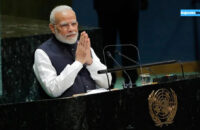On the very steps of the US Capitol, where the unruly crowd of Americans, like never before, took control of that landmark edifice of democracy on January 20, Joseph Robinette Biden Jr. took oath as well as control of USA as its 46th President. Many compared Biden’s inauguration with Franklin Roosevelt’s inauguration, which happened in 1933 amidst the Great Depression, except that then there was no rowdy horde of Americans that thronged the Capitol complex two weeks before the oath-taking event.
Three months later, the world around Biden, including USA, remains unruly and wracked by a deadly pandemic. Add to that persistent racial discrimination along with an economy plagued by unemployment. There are formidable and frightening challenges amid a gloomy scenario. A daunting climate change challenge is now becoming life-threatening, just like the way coronavirus has overcast the global skies with dreary darkness.
US back in Paris Climate Agreement
However, true to his decades long career that included 36 years as Senator and 8 years as vice president to Barack Obama, within hours of taking oath, Biden signed an executive order bringing back the United States to the Paris climate agreement. Thirty days later, as per the rules of the Agreement, on February 19, 2021, the USA officially re-entered the Agreement.
That reversed the USA’s withdrawal conveyed to United Nations on 4th November 2019 by the preceding Donald Trump administration and effected by UN, after one year again as per rule, on 4th November 2020. Biden’s order to re-enter Paris Agreement sounded like the curtain call of arrival of American leadership to counter China’s economic muscle power.
The reasons for Trump’s withdrawal from the Agreement have been jumbled and disparate throughout his presidency and even during the election campaign. He called climate-science a hoax made up by China. Then he stated that the Paris Agreement is unfair to USA’s workers and hence to American economy, and complained that India and China have benefited from the Agreement. Trump also promised to renegotiate the Paris Climate Agreement, despite knowing fully well that it has come into force on 5 October, 2016.
Biden’s decision to re-join was, not surprisingly, diametrically opposite. Biden, like the majority of Americans, strongly believes in the science of climate change. With the U.S. being the second-largest producer of carbon emissions, behind China, Biden is aware that his country has contributed more to global climate change over time and its cumulative carbon emissions are much more than any other country.
John Kerry, Biden’s climate man, is now a front line diplomat to wrinkle-out the differences among the countries, particularly developing countries, leading the way to the Paris Climate Agreement in 2015, which is hailed as an example of global participation and ‘bottom-up” approach of inviting voluntary emission reduction by each country, developed and developing.
The Agreement allows each country to work out a way to raise the targets to match the goals of limiting the temperature rise. Though a number of provisions in the Agreement are yet to be institutionalised, the intent is unique.
While campaigning for the Presidential election, Biden made a bold pledge to cut greenhouse gas emissions from the nation’s electric sector by 2035 and make the country carbon-neutral by 2050. He proposed the ‘Green Deal’ similar to what the European Union declared in COP – Conference of Parties – in Madrid in 2019. EU with its 28 member countries together is the third-largest emitter of greenhouse gases in the world after China and the United States. EU’s announcement of carbon neutrality is hailed as a major step forward.
Article 2 (a) of the Paris Agreement states the global goal of ‘Holding the increase in the global average temperature to well below 2 degree celsius abo1ve pre-industrial levels and pursuing efforts to limit the temperature increase to 1.5 degree Celsius above pre-industrial levels, recognising that this would significantly reduce the risks and impacts of climate change’.
The temperature target is based on the report of the Inter-governmental Panel on Climate Change (IPCC) that delineates on climate science, impact and the solutions.
IPCC has stated in its last report that by around 2050 the world has to be carbon neutral to meet the target of rise of temperature to 1.5 deg C and by around 2075 to limit the temperature rise to 2 deg C. Latest ‘Emission Gap’ report of United Nations Environment Programme states that present voluntary commitment – Nationally Determined Contributions (NDCs) – by the countries under Paris Agreement are far from aligning with these targets and if further ambitious targets as stated by IPCC are not taken, our planet will head towards abyss.
Carbon Neutrality is now on top of the agenda for global climate action, having failed to contain the emission-rise right from 1997 when Kyoto Protocol came into being. Carbon neutrality in simple terms means a balance between carbon dioxide e mission and absorbing the same from the atmosphere in carbon sinks – like forests, oceans and soil.
Interestingly, the Paris Climate Agreement does not include carbon neutrality as a target though it encourages enhancing the voluntary targets of emission reduction provided by the countries in the form of NDCs submitted after the Paris climate Agreement.
The fifth anniversary of the Paris Agreement in December, 2020, was a major milestone in more sense than one. First, 2020 ranks as the second-hottest year on record for the planet, knocking 2019 down to third hottest. Second, it was the month when scientists recorded the Earth’s average temperature rising to near 1.2 degree Celsius which is dangerously close to 1.5 degree Celsius target set in Paris.
Year 2020 also signaled the world should aim for the target of 2 degree Celsius, as the target of 1.5 degree Celsius is near impossible.
Japan and the Republic of Korea, alongside over 110 other countries, have pledged carbon neutrality by 2050; China vowed that it will do so before 2060.
USA and India are two major emitters who are yet to declare the net zero emission target. Many businesses and corporates are also in the process of taking the Carbon-Neutrality pledge. It is expected that President Biden would use the Earth Day Climate Summit to express USA’s resolve to be Carbon Neutral by 2050.
Climate finance a major issue
In the chorus of carbon neutrality and COVID19, there is complete silence on key issues of climate-justice, common but differentiated responsibilities and financial support to the developing countries. Biden’s climate summit could be the fulcrum and an opportunity that PM Narendra Modi along with other developing countries must use to bring these elements on top of the agenda.
The message from Article 4 of the Paris Agreement has embedded in it enhanced and ambitious targets and corresponding financial and technological support needed for developing countries. A study by the Stockholm Environment Institute in December, 2020, recalled that climate finance was enshrined way back when United Nations Framework Convention on Climate Change (UNFCCC) was signed in 1992.
As the world moves towards the most ambitious targets, including carbon neutrality, the 40 invited world leaders – nearly half of them from developing countries – at Biden’s Climate Summit must e11nsure developed nations provide ambitious financial resources.
In particular, developed countries must commit to two pathways, even in the times of COVID 19.
The first is a reaffirmation of the prior commitment to provide USD 100 billion per year to developing countries by 2020 and extend that commitment for another five years, through 2025.
The promises at COP15 held in Copenhagen in 2009 included the support starting with USD 10 billion per year leading to USD 100 Billion per year from 2020 onwards. The second, making finance flows consistent with the ambitious reductions in gas emissions as well as separate finance for climate-resilient development is known as adaptation-fund.
Five years after the Paris Agreement, how far has the international community come on the climate finance agenda? Developing countries have said there is lack of transparency in definition and in calculating ‘Climate Finance’. Developing countries were firm in stating that they needed dedicated fund. Official Development Aid, private sector finance and bilateral aid should not be counted . Developed countries are harping on counting all these flows.
The performance of ‘Green Climate Fund’, a dedicated fund, is miserable. It has so far managed cumulatively about USD 11 billion, ridiculously lower than the ambitious targets. China is now the largest emitter in the world. It has taken the carbon neutrality pledge a month back without any condition of financing by the developed countries. It is doubtful if China would support other developing countries on climate financing – the way it has done five years back.
India’s role
Fortunately, India has much credibility as, unlike China, it is well on track to meet its climate targets as provided in its NDCs to United Nations. Its joint initiative with France of the International Solar Alliance has also been considered a path-breaking mechanism that would practically add to the ambitious targets.
More than 20 top Indian private sector corporations, including Infosys, Reliance and the Tata Group have declared they would go Climate Neutral. Two hundred plus colleges and universities in India have also pledged to go climate neutral under ‘Not Zero-Net Zero’ campaign of NGO – TERRE Policy Centre’s- project of Smart Campus Cloud Network. While these initiatives will be piloting and making youth and business ‘neutrality-ready’, such positivism should be leveraged by Prime Minister Modi to position India as the country that would walk the talk.
While carbon neutrality will be the pitch during the summit, PM Modi should use climate diplomacy not only to remind the developed countries about common but differentiated responsibilities and their past commitments but also to institutionalize the mechanism and alliance jointly with the US, for tracking the climate finances to developing countries and mainstream climate justice.



Leave a Reply